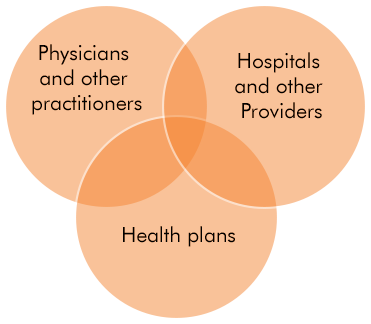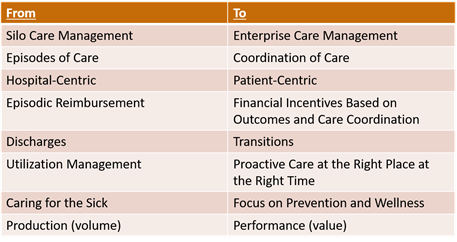The U.S. spends over $8,250 per capita on health care every year. That's 22% higher than the next highest country and 170% higher than the average of the 50 highest-spending countries in the world!
At the same time, the WHO has ranked the United States health care system as only 37th in the world. About 75% of all health care dollars are spent on patients with one or more chronic conditions, many of which are preventable, such as diabetes, obesity, heart disease, lung disease, etc.
What is the best way, moving forward, to lower costs while improving the quality of care?
The short answer: changing the paradigm from costly treatment to timely intervention.
Switching to Fee-for-Value:
a Significant Move Forward
Within the healthcare industry, we are in the middle of a shift from fee-for-service to fee-for-value, moving the locus of control from treating illness to providing preventive care.
This is beneficial to both patients and the healthcare industries.
Improved Clinical Documentation = Improved Outcome
In addition to our core (Revenue Cycle Management) RCM and medical coding business, we are seeing increased demand for improved clinical documentation.
Clinical documentation improvement:
- Ensures that providers are effectively and accurately capturing the necessary data within a patient’s health record, so that the data corresponds with the charges submitted to the insurance company.
- Leads to better care. The more accurate the data is within a patient’s health record, the better care the provider team can deliver.
This is a simple enough concept, but within the realm of healthcare it becomes quite complex, due to the intricacy of diagnosing a patient’s condition and the need to use information technology to accurately capture what is going on using a series of medical codes and free-form notes. Our teams are right in the middle of this evolution and we are helping our clients be more effective at providing cohesive, effective care to patients in every kind of environment.
Risk Adjustment Coding = More Effective Prevention
Professionals also must take into account risk stratification when considering the state of population health. As a result, we’re seeing increasing demand for risk adjustment coding, on behalf of both providers and payers.
Risk adjusted coding is used to capture the health condition of a patient based upon certain conditions such as diabetes, major depression, or heart arrhythmia.
This enables payers to allocate the appropriate monies for providers to care for patients with these health conditions. The higher the health risk of a patient, the more money is allocated.
Being able to predict risks helps medical providers deliver a better standard of care, by enhancing disease outcomes by identifying high-risk patients and allowing a team of medical providers to offer coordinated care.
The Triple Aim

The Triple Aim in Healthcare is a concept put forward by the Institute for Healthcare Improvement. It is intended to drive healthcare organizations and providers to simultaneously implement programs that
- Improve the patient care experience
- Improve the health of patient populations
- Reduce the per capita cost of health care
Clinical integration is the emerging structure to manage such value-oriented contracts. As the leading response to market demand for value, hundreds of health systems are pursuing the clinical integration model. The bottom line is that a lack of integration leads to poor clinical outcomes and therefore, overall, higher healthcare costs.
What Does an Integrated Delivery Model Look Like?
The integrated delivery model is patient-centric. It has three major components:
Acute care (think beds) includes hospitals of all types and any facility designed to treat acute conditions.
Ambulatory care (think no beds) includes clinics, physician offices, urgent care, pharmacies, and telemedicine.
Post-acute care includes skilled nursing facilities, hospice, home health agencies, and durable medical equipment providers.

These providers work in concert with payers to deliver the right care, in the right setting, at the right time. With an emphasis on treating the whole person, a shift is made from treating illness to preventing it. Clinical integration facilitates the coordination of care across conditions, providers, settings and time in order to achieve patient care that is safe, timely, effective, efficient and patient-focused.
What Does This Mean for The Revenue Cycle?
According to Healthcare Financial Management Association (HFMA), in 2015, 6% of payer/providers reported that 50% of their contracts were value-based. In contrast, by next year, 67% believe they will have 50% of their contracts as value-based.
To some, these projections seem overly aggressive; however, we can expect the transition from fee-for-service to fee-for-value to continue in the healthcare provider and payer industries. At the heart of either model - accurate coding, timely claim processing and accurate and timely collections will be required from a revenue cycle standpoint. Companies that can provide direction, sound advice, systems, processes, people and tools will be essential to any health systems’ or payers' strategy for growth.
Companies that take a patient-centric view while interchanging information among a variety of provider and payer types will thrive.

Effective Change Starts with Leadership
At Vee Healthtek, we are at the forefront in offering guidance and solutions that help position our clients as they evolve into new payment models. To address these needs, our revenue integrity, clinical documentation improvement, risk adjustment, and provider data management teams are helping health systems and payers move closer to integrated network models.
We create IT service offerings customized to each client’s environment and business objectives. These services can include anything from advanced analytics to offering robotic processing automation solutions, which replicate a human’s keystrokes at a machine’s user interface. App development services are available to provide patients insight into appointment wait times and their own medical records.
Our coding and revenue cycle processing teams include talent from the U.S. and India, allowing our clients to take advantage of time zone differences and run 24-hour revenue cycle management operations. We have equipped our clients with onsite partner-level healthcare executives and operations professionals to ensure business objectives are met.
We strive to live our value proposition that accuracy, competency, and teamwork lead to extraordinary outcomes.
Working in the Real World

Two university-based health systems – one in North Carolina and another in Massachusetts – came to Vee Healthtek for help moving to value-based systems. For each, we implemented programs and services designed to identify the health status of patients while providing insight into hierarchical condition categories (HCC). As a result, these health systems have been able to stratify their entire patient population and identify the sickest patients within it. Integrated, multi-disciplinary care teams can then coordinate and proactively provide exceptional, comprehensive care that focuses on the whole person. As a result, patients have better disease outcomes and their quality of life is improved.
By harnessing the power of technology-enabled services, working in concert with physicians to treat the whole person, Vee Healthtek has been able to tap into its spirit and core values to deliver positive, paradigm-shifting outcomes for its clients, and the patients that they serve.

